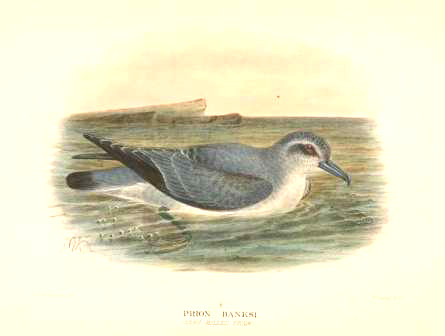


Mathews, Gregory, The Birds of Australia 1910-28.
M ore than a week of severe storms blowing up from the Antarctic has left thousands of sea birds wrecked across New Zealand, not just along the coast but well inland. A local landowner brought in a bird for me this morning, wanting me to help indentify it. After much measuring of the dead bird and consulting of the identification guides, we determined quite confidently that it was a broad-billed prion, and not an antarctic prion which were being reported as being wrecked in large numbers in and around Wellington. The local bird rescuer, the reverend Robin List, confirmed that all the birds he had coming in from around the Wairarapa were broad-billed. So.
A wreck is when very large numbers of seabirds die and become wrecked around the coast. Sometimes it involves mainly one species, or at other times several species. Some wrecks seem to be caused by storms catching young birds a few days after leaving their nests, others by storms combined with a food shortage. Birds found dead or dying on the beaches are usually only a small fraction of what is occurring at sea. New Zealand lies in the path of seabirds moving eastward in winter from the southern Atlantic and Indian Oceans. Wrecks of 13,000 prions that came ashore in New Zealand during June and July 1964 showed obvious signs of starvation as did a wreck of prions that occurred in 1981 in South Africa and in Chile in 2007. Analysis of dead birds washed up on the world's coasts remains one of the main ways of studying seabird movements throughout the year. The El Niño/Southern Oscillation, a warm water Equatorial current that irregularly flows south along the Chilean and Peruvian coasts is well known to disrupt marine and terrestrial ecosystems and to raise havoc among some seabird populations.
Prion taxonomy has a controversial history, but according to the Heather & Robertson Field Guide, there are two subspecies of these small petrels of the southern ocean, desolata which breeds at the Kerguelen and Crozet Islands in the central Indian Ocean, and banksi which breeds in the South Atlantic Ocean, on Heard and Macquarie Islands, and in the New Zealand region, on the Auckland Islands and Scott Island in the Ross Dependency.
“The Antarctic prion was taken at Kerguelen or Desolation Island in 1768 during Cook's first voyage, hence the specific name bestowed by Gmelin. It was taken on The Auckland Islands by the British Antarctic Expedition in 1840 and found breeding there by the National Antarctic expedition in 1907. On Macquarie Island it was found breeding by J.H. Scott in 1880, says Oliver. "Scott called this prion the ‘Night-bird’ and says that it makes its nest in burrows under tussocks where it can be heard during the day cooing like a dove. It leaves its nest at nightime and picks its food up at sea, a short distance from the land.”
They are summer breeders and are the largest of the prions, with a wing span of 17-20cm.
Three species of prion, including this one, have flattened bills with a fringe of lamellae that act as strainers. All prions are marine and feed on small crustacea such as copepods, ostracods, decapods, and krill, as well as some fish such as myctophids and nototheniids.
The prions belong to the Procellariiformes, which were formerly called Tubinares, or tubenoses, and now are generally called petrels. They are almost exclusively pelagic and have a cosmopolitan distribution across the world's oceans, with the highest diversity being around New Zealand.
Procellariiformes have an enlarged nasal gland at the base of the bill, above they eyes. This gland rids the birds of the salt they ingest from sea water. Scientists are uncertain of its exact processes.
— Greytown, July 2011

| Taxonomy | |
|---|---|
| Kingdom: | Animalia |
| Phylum: | Chordata |
| Class: | Aves |
| Order: | Procellariiformes |
| Family: | Procellariidae |
| Genera: | Pachyptila |
| Species: | desolata |
| Sub Species: | desolata, banksi |
dove prion, Totorore, Whiroia
Native bird
26 cm., 150 g., sexes alike, upper parts blue-grey, under parts white, white eyebrow, dark patch under the eye, a black M-shaped mark across their wings, and a broad black tip to their tail, blue bill, legs blue. Have a wider bill than fairy prions.
Regularly appears off the NZ coast in winter and spring.
Mathews, G.M., Birds of Australia, 1910-27.
Heather, B., & Robertson, H., Field Guide to the Birds of New Zealand, 2000.
Readers Digest Complete Book of NZ Birds, 1985.
Olliver, W.R.B., New Zealand Birds, 1955.
Sunday, 13 August, 2023; ver2023v1